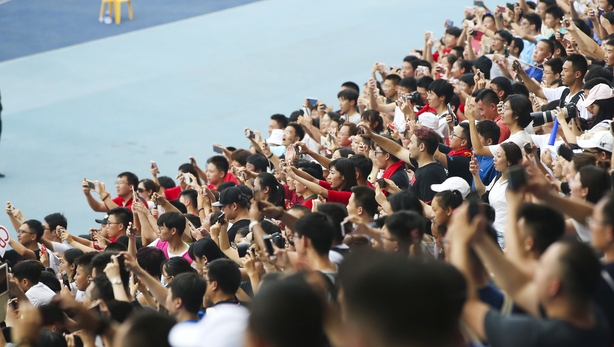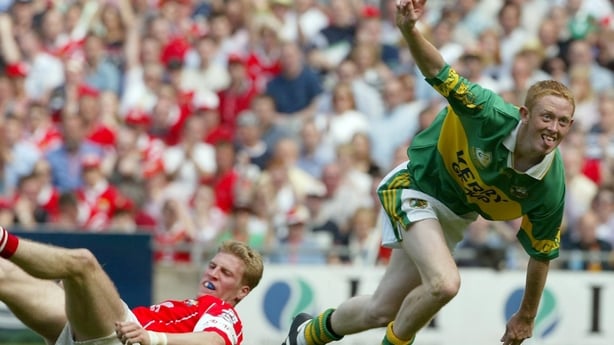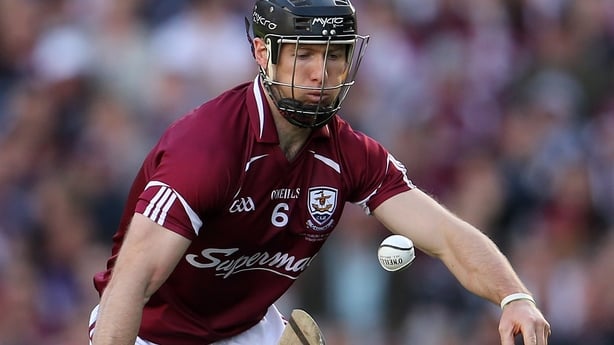Last week, Limerick’s Gearóid Hegarty retweeted a picture of two photographs set beside one another: one from Tiger Woods golfing in 2002, and one of Woods teeing off in 2018.
The image from 2002 showed an attentive audience in thrall at Woods, while the recent photograph showed a large group of people in the gallery, almost every one of whom had their smartphones raised in the air, either taking a photograph, or recording every second Woods spent before them.
The caption below the photos read: ‘Watching with our eyes versus watching through our smartphones.’
Hegarty added his own comment to the retweet. ‘A picture paints a thousand words,’ he wrote. ‘Can never understand why people watch concerts/sporting events etc through their phones.’
The people who do think they are creating memories but they are really doing the opposite.
Tiger Woods golfing in 2002 & Tiger Woods golfing in 2018.
— Yoni (@OriginalYoni) August 10, 2018
Watching with our eyes versus watching through our smartphones. pic.twitter.com/BpSxT1yTDa
They are capturing a series of random snapshots that are divorced from what following sport, or attending concerts, should be about – living the moment, fully absorbing the experience.
Last December, Eric Andrew-Gee wrote in The Globe and Mail Inc. about how smartphones have changed the way we communicate, of how they have reshaped the way we think and interact.
The article was titled, ‘Your smartphone is making you stupid, antisocial and unhealthy. So why can't you put it down?’
Andrew-Gee referred to a growing body of research by psychiatrists, neuroscientists, marketers and public health experts to show how smartphones are causing real damage to our minds and relationships, ranging from reduced brain power, declines in work-life balance and hours less of family time.
"They have impaired our ability to remember," wrote Andrew-Gee.
"They make it more difficult to daydream and think creatively. They make us more vulnerable to anxiety. They make parents ignore their children.
"And they are addictive, if not in the contested clinical sense then for all intents and purposes."

Average users look at their smartphone around 150 times a day; many people spend somewhere between three and five hours a day looking at their hand-held portable computers, which amounts to about seven years over the course of an average lifetime.
Smartphones are designed to be addictive. Yet that addiction is becoming a major societal worry, primarily because people are not developing the attention muscles in their brain nearly as much as we used to.
In his article, Andrew-Gee noted how John Ratey, an associate professor of psychiatry at Harvard Medical School and an expert on attention-deficit disorder, said the issue has become so serious that Professor Ratey has noticed a convergence between his ADD patients and the rest of the world.
The symptoms of people with ADD and people with smartphones are "absolutely the same," he said.
Connectivity has never been easier through technology but some of the side-effects are extremely worrying.
In his excellent presentation at the GAA's Coaching Conference in January, Tony Óg Regan showed a picture of a goldfish to make a point; the average attention span of a human in 2000 was 12 seconds; in 2013, it was eight seconds.
Regan now estimates its between 4-5 seconds.
"And a goldfish's attention span has remained at nine seconds," said Regan.

As a sports psychologist, connecting with players is at the core of Regan's work.
From his research, Regan could tell his audience that when a player comes to training on an evening, he could have read up to 174 newspaper articles that day.
That huge volume of information already floating around in a player's head, combined with a decreasing attention span, certainly demands much more of coaches now.
"Can you deliver a team talk in seven or eight seconds?" asked Regan.
"Because otherwise, you’re often just putting confusion into a player’s head, and he has no clarity."
All that distraction also restricts the natural ability to just connect through basic conversation.
When Colm Cooper retired last year, Paul Galvin wrote a column about a visionary player whose creative genius was defined by a cutthroat attitude.
In the process of making his point, Galvin spoke about the harmful effect WhatsApp is having on teams, and how it is softening the hard mentality he saw in guys like Cooper.
"It's all smiley-faces, thumbs-up and virtual high-fives from the couch," wrote Galvin.
"Honest, frank, face-to-face exchanges on the training ground or dressing room feel like a thing of the past.
"This is where team culture should be created and driven, not on an app.

"It should but this is a new culture now. Everywhere. Dealing with this new technological age is one of the greatest challenges facing parents, especially when contact and communication with children is so heavily diluted through the constant use of smartphones, iPads, laptops, hand-held devices, X-Boxes, and TV."
It has also presented coaches with a huge challenge, as Regan outlined, especially in getting their message across.
Regan’s presentation at that Coaching Conference was titled ‘Creating better decision makers under pressure’.
He spoke, and adapted on, numerous different elements; of how the top players recognise the developing play earlier, primarily because they extract the minimum essential information, and have a superior knowledge of situational probabilities.
Coaches also need to be mindful of those concerns surrounding decreasing attention spans, especially considering the explosion of analysis and data in the GAA, especially at inter-county level.
With every team forensically analysing each other, players want to be informed. But how do you manage it without overloading them with more information than some can, or want, to take in?
There is certainly a balance to be found.
If coaches and performance analysts can provide information that is engaging, then there is more critical thinking involved.

Relevance is also everything.
There should always be a credible reason and purpose for why a coach or manager wants certain information.
Because if he or she wants it just because they heard some other team are measuring it, the information is probably worthless and irrelevant anyway.
And it will only eat into players' time. Some players eat information up. More have little or no interest in forensically studying the opposition, but most have a threshold as to how much data they can process.
And endless hours of analysis meetings can push them far beyond that point.
There is often a coldness to the clinical nature of statistics and analysis but player empathy has never been more important.
Especially when footage is often taken from multiple camera angles, and coldly dissected in a dark room.
Could the player really have seen that pass? The best coaches find that balance between handing responsibility to the players and providing the leadership and governance that elite players now expect.
They also seek to create an environment heavily defined by interaction and engagement.
As a coach, how do you create that environment? How do you improve decision making? Communication and feedback are critical.
Players invariably respond favourably when they are handed more responsibility, and when they are made feel more valued.
Because the best managers and coaches still care about the individual first.
"It all comes back to the person in front of you," said Regan at the conclusion of his presentation in January.
"Don’t underestimate the impact of sitting down with a player for an hour and a half, as opposed to doing five extra sessions. You can often get so much more from a player by just connecting with him or her."
And in a society so heavily defined and dominated by technology, any amount of texts, or emoji's, can't get that message across.


